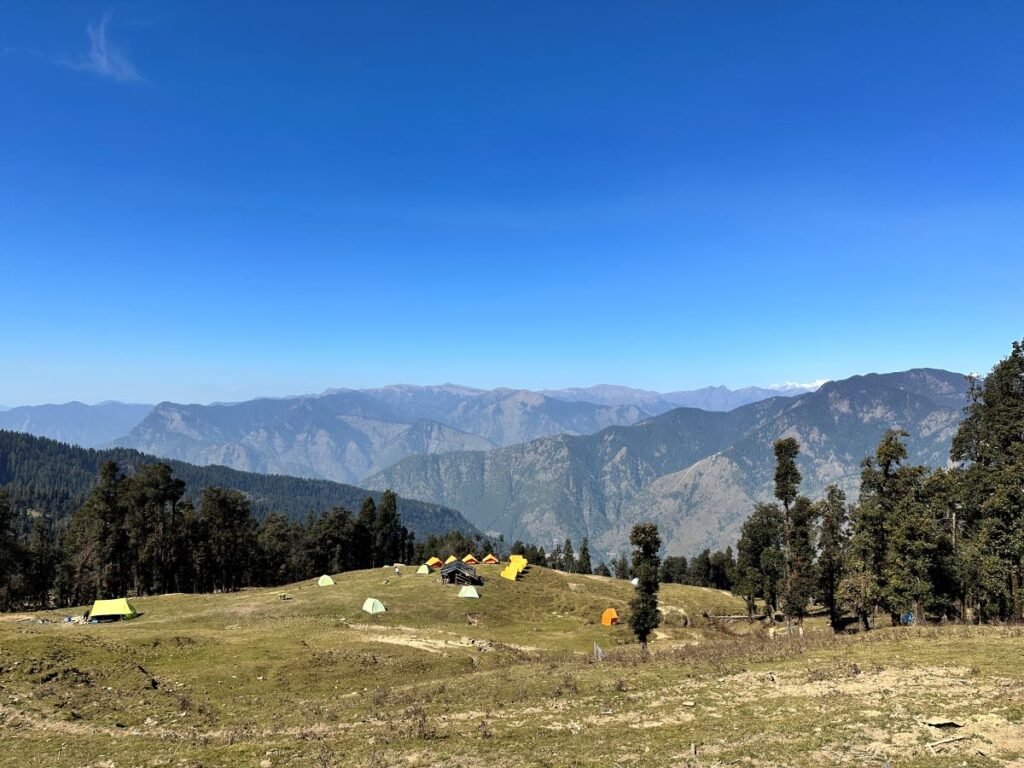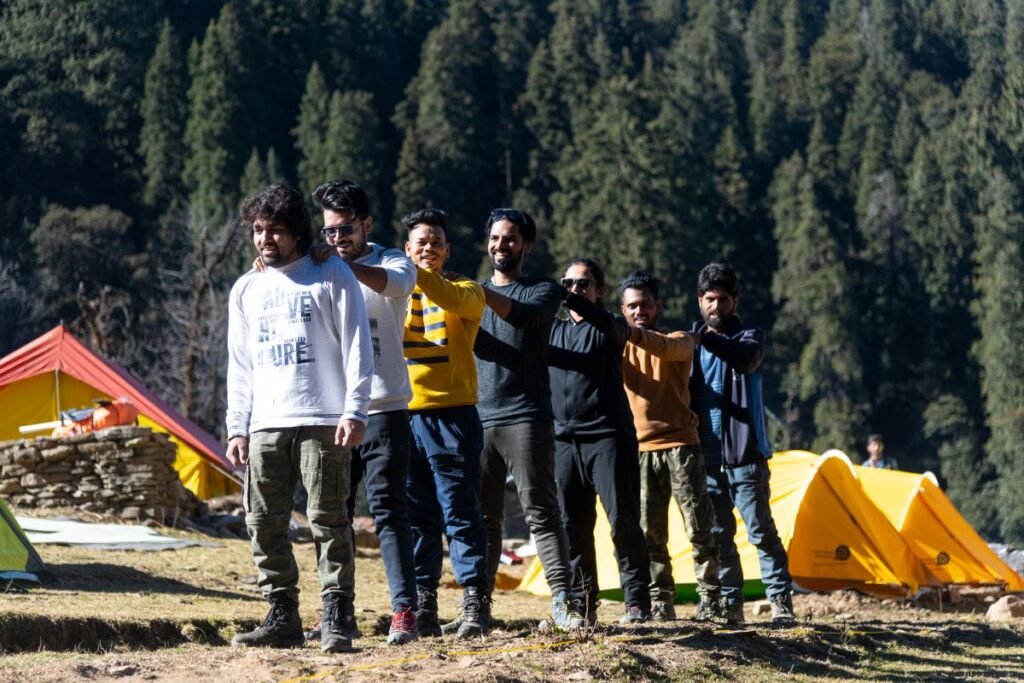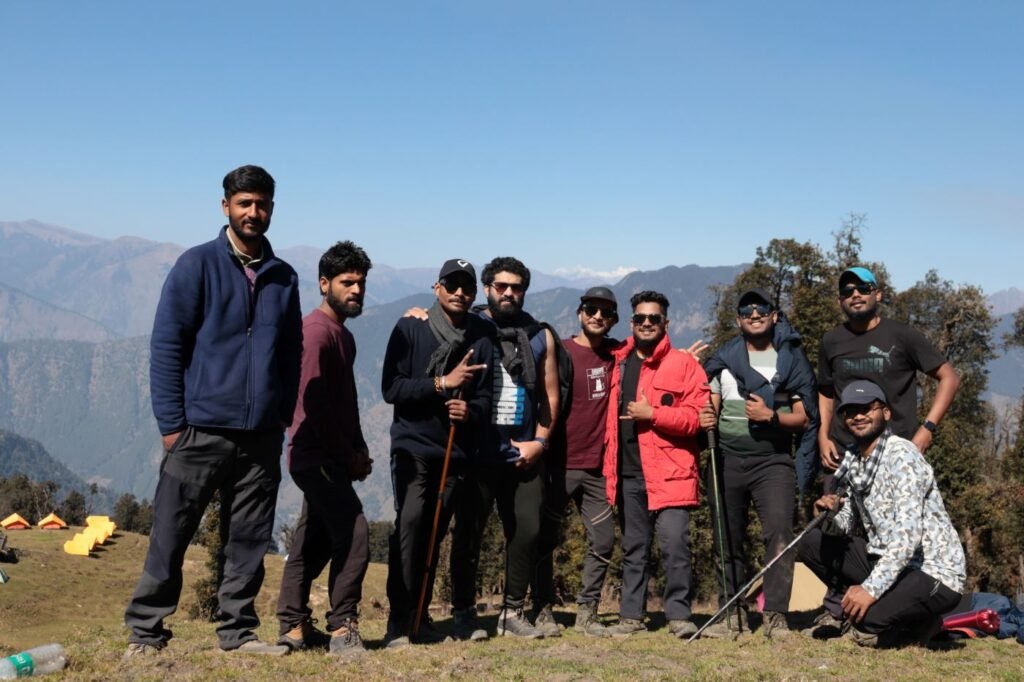Kedarkantha Trek Overview
One of India’s most popular trekking routes is the Kedarkantha trek, particularly in the winter. This trip, situated in Uttarkashi’s beautiful Govind Wildlife Sanctuary, offers amazing views, a wealth of cultural experiences, and the opportunity to see various wildlife. Kedarkantha offers an unforgettable experience for all trekkers, no matter their experience level.
The trek is amazing as it comprises pine forests, meadows, and campsites along with snow-capped peaks offering captivating views of Swargarohini and Bandarpoonch. This is an easy to moderate trek that lasts for 6 days and is suitable for experienced trekkers and beginners.
The Kedarkantha leads the way to a wonderland covered with thick layers of snow, offering one of the best winter treks in Uttarakhand. We’ll start from the base camp and the view gets better and better as we head for the summit. The trekkers usually get lost surrounded by snow-clad trees and frozen glacial lakes. The trees are everywhere and lakes are sealed with ice. These views are enough to transport the trekkers into an entirely different terrain. The route also provides an opportunity to meet different villages occupied by locals; their daily life with Garhwali culture makes the trip interesting. Whether it is your first trek or the hundredth, it does not make a difference; Kedarkantha Trek will be a beautifying experience.
The Kedarkantha Trek’s itinerary
Day 1- Dehradun to Sankri
Dehradun, the charming city of Uttarakhand where you begin your journey is indeed popular for its greenery and cultural history. Upon arrival, you will meet your trek leaders and teammates, who will accompany you on this journey. You will be driven to Sankri, a village located in the lap of the Himalayas after a brief introduction. As you begin the wonderful drive of 200 kilometers, prepare to be spellbound by the views that come in on all sides during the journey. You can see high hills and green plains as you drive along the mountains. Since there will be numerous chances to see beautiful places, shooting pictures as an attendant to some places will be necessary.
Go deep into the mountains and enjoy the sight of vibrant markets and colonial structures. As you progress, the temperature becomes cooler and the green leaves turn into the enchanted sight of pine trees.
As soon as you reach Sakri which is approximately 6400 feet above sea level, the inhabitants will surely greet you with warm kindness. This picturesque town serves as a good base for a few trekkers in the area. After check-in at the hotel, a few more activities in the village can be planned.
Day 2- To Juda ka Talab from Sankri
After having breakfast to pack some energy for your day, you will go for your first walk and reach a distance of about 5 kilometers from Sankri to Juda Ka Talab. The day begins with a gentle hike through dense pine trees as the earthy smell of the pines drifts through the surroundings. Take a look at the various plants and animals which are found around you.
After a couple of hours of hiking, you will arrive at the glacial lake of Juda Ka Talab which is surrounded by pine trees and tall mountains. The lake is located at an altitude of 9000 feet and is one of the trekker’s resting places. In winter this lake is often frozen which creates a beautiful winter scene. Heaven is here, a snow-bound valley in which absolute tranquility and beauty prevail. Winter scenery at this quiet retreat is simply breathtaking.
Day 3- Juda ka Talab to Kedarkantha Base Camp
On your third day of the hike at an elevation of 11,200 feet, you will head towards the Kedarkantha Base Camp. You will set off for a steep climb of about 4 kilometers after breakfast. The terrain comprises low-angled alpine meadows which are in full bloom with colorful wildflowers.
The scene shifts as you climb up and stunning views of the mountains around the area can be seen. The atmosphere becomes more peaceful as the air gets clearer and you can hear the sound of your boots hitting the soil.
As we proceed further the scenery changes giving beautiful views of the highlands, the air becomes fresher. You trekkers have and will seek similar encounters with other trekkers or with nature on that day’s treks. Let this be an avenue to engage others in your trekking sessions or the wonderful sights you are witnessing. It is clear that as the base camp nears, the anticipation increases and so does the happiness.
As you step into the Kedarkantha Base Camp, you are greeted with a breathtaking view of the towering Kedarkantha peak. The vast pastures which in winter turn into a white carpet of snow make this campsite ideal for.
Day 4- Kedarkantha trek to Juda ka Talab
A trek from Kedarkantha Base Camp to the summit is the first event of the day that commences at around 4:00 A.M. The three-kilometer path starts with a low incline up until the last stretch in which the incline stiffens. You are directed along the path by mesmerizing sights and snow covered fields.The high point of the day is reaching Kedarkantha Peak, which is 12500 feet above sea level in time for sun rise. From the summit of the peak, enjoy an amazing view that include famous peaks like Swargarohini, Bandarpunch Mountain and Black Peak. It is quite a spectacular visual to see the sun rising on the snow capped mountains.
Once you have enjoyed the view, you can expect to commence your return journey which is much easier than what you can imagine. Around one to two hours is expected for this trip. After reaching your campsite, there is a very brief chance to rest recharge, and start preparing yourself for the next part of the hike to Juda ka Talab.
The 3-km inclined track that goes down to Juda ka Talab enjoys a scenic and gentle path amidst the thick pine and oak forests. The experience of moving through the jungle is more fun, and as you approach the Juda ka Talab, the scene reveals a beautiful lake at an altitude of 3500 feet, which is enveloped with thick forests enhancing the charm of the region.
DAY 5. The Returning
After having breakfast, you will leave Juda Ka Talab and walk the last six kilometers to Sankri Village. It’s an additional 6 kilometers from this trek which can be described as a gentle walk that provides the most astonishing sight of the snow-capped peaks around while walking through the same gorgeous coniferous and oak trees that were seen on the way up. On this part of the trek, it feels serene when you walk since you have an easier terrain and a fresh mountain breeze. There is plenty to see and reflect on the last few days of the trek while walking.
The Best Time to Visit the Kedarkantha Trek
Winter (December to February) – During the months of winter Kedarkantha is at its best and the most beautiful site to trek. The region becomes a winter wonderland with lots of heavy snow cover, frozen water bodies, and pine trees covered with snow. This time is best for snow trekking; the sights of the peaks in the surroundings are beautiful. The cold air, bright skies, and the pleasure of walking on snow peaks make this season the favorite among adventure lovers. The winters and the cold make the months best suited for those who are looking for snow trekking, hence making it one of the best winter treks in Uttarakhand.
Spring (March to May) – Spring is also a good season for trekking, although it cannot be compared to winter which is covered with heavy snow. The surroundings start filling with stunning flowers and the paths are covered in green bushes. It is moderate weather and trekking conditions are decent. Though there is no snow, the lively colors bloom all over the place, and still fantastic views of the surrounding peaks make this season a delight for the trekkers.
Summer (June to August) – The warm weather draws crowds of people to various hiking trails, now bursting with green leaves. However, by the middle of July, the monsoon season arrives, accompanied by rain that can make trekking conditions very difficult. This time of year is also bad for treks due to the threat of landslides in certain areas. If summer is the only option, try to trek in the earlier months, well before the rains set in.
Autumn (September to November) – Another favorable time to travel to Kedarkantha is autumn; the skies are already mostly clear, the weather is nice, and there aren’t as many people on the trail as there are in the summer. The trail is still green after the monsoons and rain is not a threat. All snow-capped mountains are still visible but this trek is devoid of winter’s snow-covered magical ambiance.
The Level of Difficulty of the Kedarkantha Trek
Since the Kedarkantha trek is categorized as a moderate trek, beginners with a moderate level of fitness and expert trekkers can complete it. Even though some parts can climb difficult and high, most people find the journey to be satisfying and appropriate overall.
The Kedarkantha trek has steep climbs and high altitudes but given the terrain’s gradual incline, most people will find it comfortable and manageable. The trek manages to be difficult yet at the same time fun, with no shortage of breathtaking views, snow-filled meadows, and beautiful campsites. Besides, the Kedarkantha is overall a great trek and provides satisfaction to anyone who undertakes it regardless of their experience level.
Getting Ready for Physical Fitness
- Lower body exercise: To strengthen your legs, which are essential for trekking, include lunges, squats, and step-ups in your program.
- Upper body exercise: To increase upper body strength, incorporate bodyweight rows or pull-ups. This will make it easier for you to manage your bag and go across rough ground.
- Core activities: To strengthen your core, which helps in stability and balance during the trek, concentrate on activities like planks and sit-ups
- Full body/cardiovascular exercise: To increase your general endurance and cardiovascular fitness, try swimming, cycling, or running.
Safety Rules and Guidelines for the Kedarkantha Trek
Getting adjusted: Give yourself enough time to gradually adjust to the altitude. This will lessen the likelihood of altitude sickness.
Weather preparation: Be ready for unexpected temperature shifts. Keep layers of clothes on hand to keep dry and comfortable.
Hydration and nutrition: To sustain energy levels throughout the walk, consume a lot of water and wholesome food.
Health and first aid: Be mindful of any personal medical concerns and keep a basic first aid kit on hand for small wounds.
Safety equipment: Make an investment in warm clothes, strong trekking shoes, and necessary equipment like a sleeping bag and backpack.
Essentials of Backpacking
Bring a legitimate ID along with any permits needed for the trek
For better vision at night, don’t forget to bring trekking poles, sunglasses, and a headlamp
To ensure hygiene, include hand sanitizer, toothpaste, toothbrushes, and biodegradable soap.
Wear a warm cap, gloves, trekking trousers, and strong trekking boots. Layer your clothing to adapt to changing temperatures.
To Get to Kedarkantha Trek’s Base Camp
By Air: The Kedarkantha trek’s base is approximately 200 kilometers from Jolly Grant Airport situated in Dehradun. This airport has connections with the major cities like Delhi and Mumbai enabling passengers to fly in and out regularly. Upon reaching Dehradun, visitors can utilize taxis or buses to go to Sankri, the trek’s base. Dehradun to Sankri via road takes 6-7 hours but has beautiful scenes during it and is thus ideal for trekkers.
By Road: Kedarkantha Trek has its base in Sankri which is well connected via road with several cities including Dehradun, Mussoorie, and Delhi. Now from Dehradun one can either take a bus or a taxi which takes around 6-7 hours and the distance is approximately 200 km so that they may reach Sankri. The options available for this route are both public and private transport facilities. The journey is 6-7 hours long and cuts across beautiful villages, thick forests, and stunning views. For many trekkers, the road is the preferred mode of travel because of its scenic routes and the latitude at which to travel during winter.
By Train: Dehradun Railway Station is the most convenient point of access to the Kedarkantha Trek, and it is connected to the major cities of Delhi, Mumbai, and Kolkata. After arriving at the station, you can take a taxi or catch a local bus to reach Sankri. The journey by train to Dehradun is comfortable and beautiful, as the train travels across the northern plains and the foothills of the Himalayas. After Dehradun, the drive towards Sankri is approximately 6 – 7 hours and takes you to the base of the Kedarkantha trek.
From Dehradun to Sankri Base Camp
Private and Government Buses: These buses offer a comfortable ride between Dehradun and Sankri and run regularly
Taxis: These convenient and adaptable modes of transportation are easily available for direct travel to Sankri
Map of the Kedarkantha Trek Route
A thorough route map that highlights important sites and landmarks along the way is crucial for traveling. The Kedarkantha trek starts from Sankri which is a small yet charming village at an altitude near 6400 ft. From Sankri, trekkers trek through Juda Ka Talab (a beautiful lake), base camp, and finally, the Kedarkantha Peak at an altitude of 12,500 feet. The path taken is filled with stunning views such as meadows covered in snow, thick pine trees, and many mountains. Here, a detailed map ensures the trekkers are on the right path and thus the journey is safer and more fulfilling.
Frequenty Asked Questions
1. What Should One Pack for the Kedarkantha Mountain Trek?
Bring the necessities, such as an adequate backpack, trekking shoes, clothes, food, and personal documents.
Why choose Himalayan Daredevils for Trekking?
A quick and delightful trek is guaranteed by their professional guides, personalized itineraries, and dedication to safety precautions.
What Time and Location will be Designated for the Initial Pick-Up from Dehradun?
The itinerary will determine the exact time of the pickup, which often takes place at a specified area in Dehradun.
What Time of Year Does Kedarkantha Experience Snowfall?
December is usually when snowfall starts, giving trekkers an amazing winter scene.
In January, is the Kedarkantha Journey Safe?
Yes, the trek is usually safe in January, but you must have the right equipment and take the right measures.
How Far are Kedarkantha and Kedarnath from one Another?
Driving the about 222 km route is a beautiful experience.
What is Kedarkantha’s Lowest Temperature?
It can go as low as -10°C in the winter, so wearing thick clothes is important.
Photo Gallery






Address: 204, Saharanpur Rd, Shanti Vihar Colony, Subhash Nagar, Shewala Kala, Uttarakhand 248171
Email: info@himalayandaredevils.com , himalayandaredevils@gmail.com
Phone: +91 7895 207206 , +91 6398 989097
